You'll need several essential tools to create successful aromatherapy soap at home. Start with precision measuring equipment like digital scales and thermometers to guarantee accurate ingredient ratios. Don't forget safety gear including goggles, gloves, and protective clothing. A high-quality immersion blender, silicone molds, and proper storage containers are also vital. For consistent results, invest in pH meters and essential oil testing equipment. The right tools will transform your soap-making journey from basic to professional-grade.
Precision Measuring Equipment for Essential Oil Blending
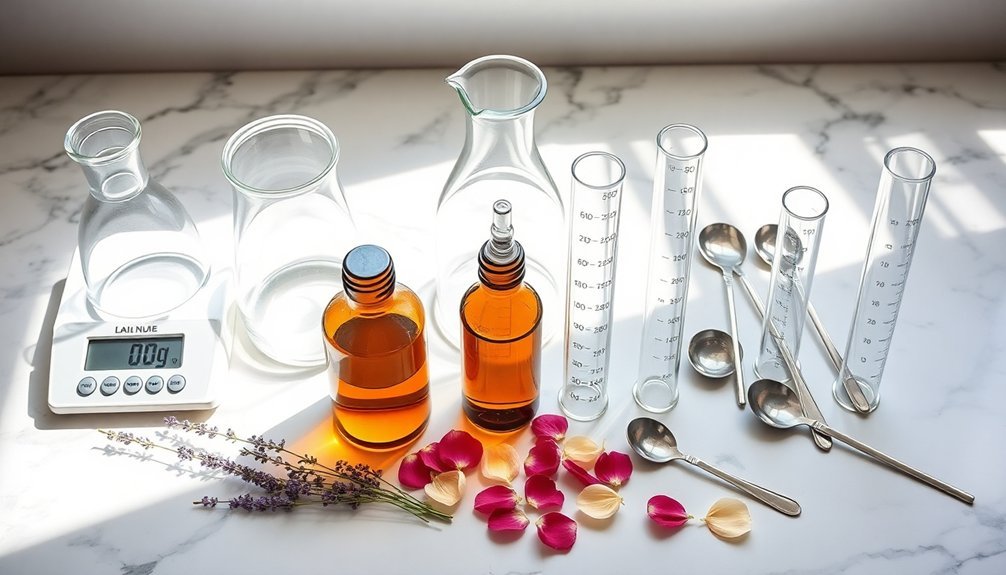
Three essential measuring tools are vital for creating perfectly scented aromatherapy soaps.
You'll need a digital kitchen scale to weigh your essential oils accurately, ensuring your formulations remain consistent and safe. A jeweler's scale provides the precision required for measuring smaller quantities of oils when creating intricate blends that make up 15% to 30% of your total formula.
Don't rely on volume measurements like cups or spoons – they won't give you the precise measurements needed to prevent skin irritation.
Weight measurements are essential for essential oils – volumetric measurements can lead to dangerous inaccuracies and potential skin reactions.
Instead, invest in easy pour containers that'll help you transfer your essential oils without waste. These specialized measuring tools work together to help you achieve the perfect balance in your soap making process, guaranteeing consistent results and safe products every time.
Safety Gear and Protective Equipment
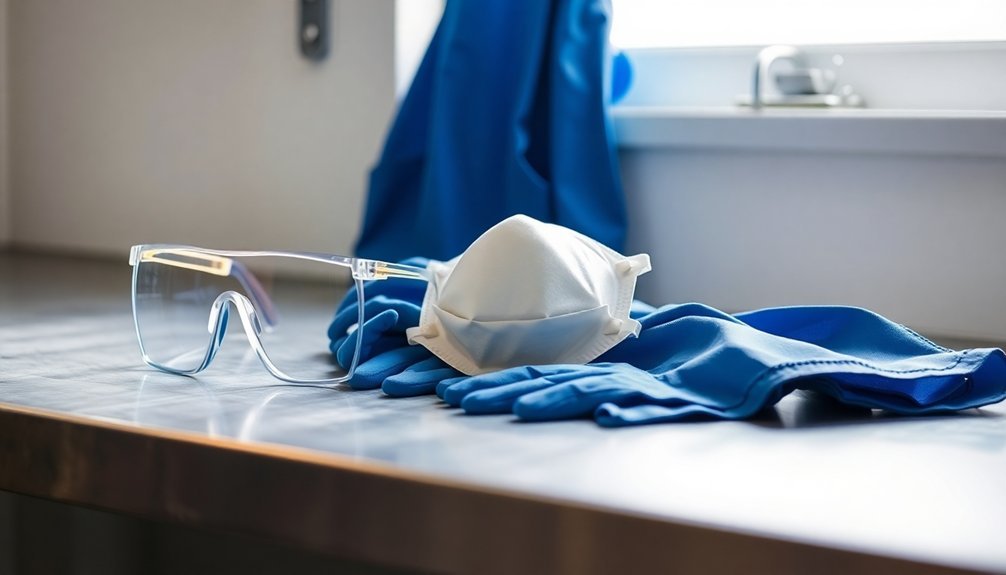
Beyond measuring tools, proper safety equipment forms the backbone of successful aromatherapy soap making.
You'll need to protect yourself from potentially harmful ingredients, especially when working with lye. Start with safety goggles to shield your eyes from soap batter splashes, and wear disposable gloves made of latex or nitrile to protect your hands from caustic solutions.
Don't forget to wear long sleeves, pants, and closed-toed shoes to minimize skin exposure. If you're making larger batches, you'll want a respirator mask to avoid inhaling harmful vapors from hot lye solutions.
Always keep a first aid kit within reach for quick response to any accidents. These essential safety items aren't optional – they're your primary defense against injuries during the soap-making process.
Specialized Mixing and Blending Tools
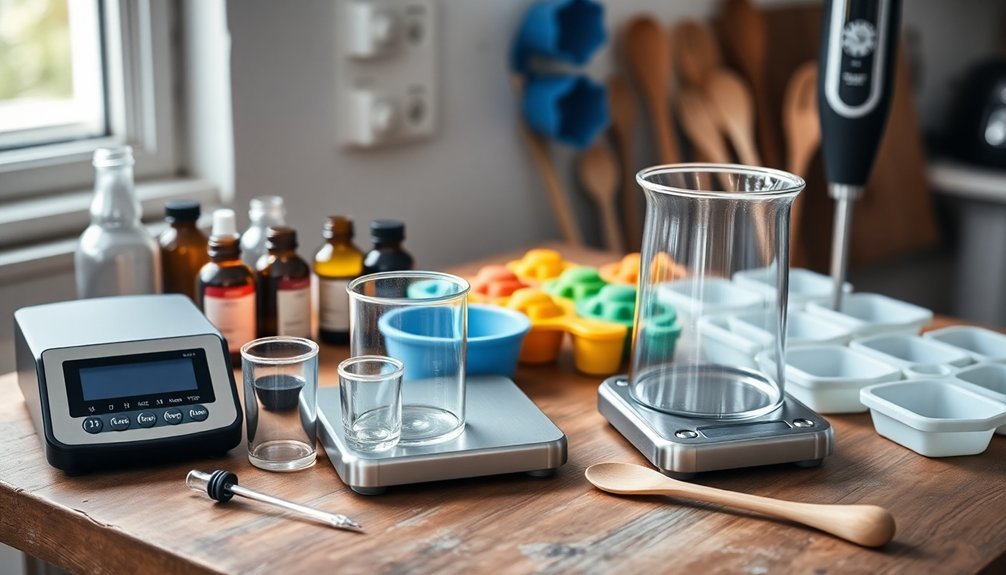
To create professional-quality aromatherapy soaps, you'll need a high-shear immersion blender with holes in the head for proper emulsification and rapid saponification.
Your mixing toolkit should include easy-pour containers for precise batter distribution and a mini mixer specifically for blending essential oils and colorants into carrier oils.
An accurate digital or infrared thermometer will help you maintain ideal temperatures throughout your blending process, ensuring consistent results every time.
Precision Blending Equipment Essentials
When crafting aromatherapy soaps at home, precise blending equipment makes the difference between success and failure.
You'll need a high-shear immersion blender with holes in the head to create strong emulsification between oils and lye, ensuring proper saponification while cutting your mixing time dramatically.
Keep your precision blending process on track by using an infrared thermometer to monitor both lye solution and oil temperatures – they should be around 100°F for best results.
Don't forget to invest in a jeweler's scale for measuring tiny amounts of essential oils in your soap recipes.
To complete your setup, add Easy Pour Containers to your toolkit. They'll help you achieve those intricate designs and swirls with minimal waste, making your aromatherapy soap crafting both efficient and professional.
Scent Mixing Tool Selection
Successful aromatherapy soap making requires specialized mixing tools that preserve and enhance essential oil potency. You'll need a stick blender or high-shear immersion blenders to create a stable emulsion when mixing the lye solution with essential oils. Temperature measurement tools help you monitor ideal conditions for scent retention.
| Tool Type | Primary Function |
|---|---|
| Jewelers Scale | Precise oil measurement |
| Easy Pour Containers | Controlled distribution |
| Infrared Thermometer | Temperature monitoring |
Your blending tools directly impact the quality of your finished soap. High-shear immersion blenders guarantee thorough incorporation of essential oils throughout the mixture, while accurate measuring devices help you achieve consistent fragrance strength. When you combine these specialized tools with proper temperature monitoring, you'll create well-emulsified soap batters that maintain their therapeutic properties.
Advanced Dispersion Methods
Mastering advanced dispersion methods requires a strategic combination of specialized mixing tools that work together seamlessly.
You'll need high-shear immersion blenders and stick blenders to achieve proper emulsification of your oils and lye solution, guaranteeing your essential oils are evenly distributed throughout your soap mixture.
To create consistent results, use mini mixers to blend your colorants with lightweight oils before adding them to your main batch.
Keep track of temperature using an infrared thermometer to prevent overheating that could compromise your mixture.
When you're working with intricate designs, easy pour containers will help you achieve precise swirls while minimizing air bubbles.
This combination of tools won't just save you time – it'll greatly enhance your soap's texture and guarantee professional-quality results in your aromatherapy creations.
Temperature Control and Monitoring Devices
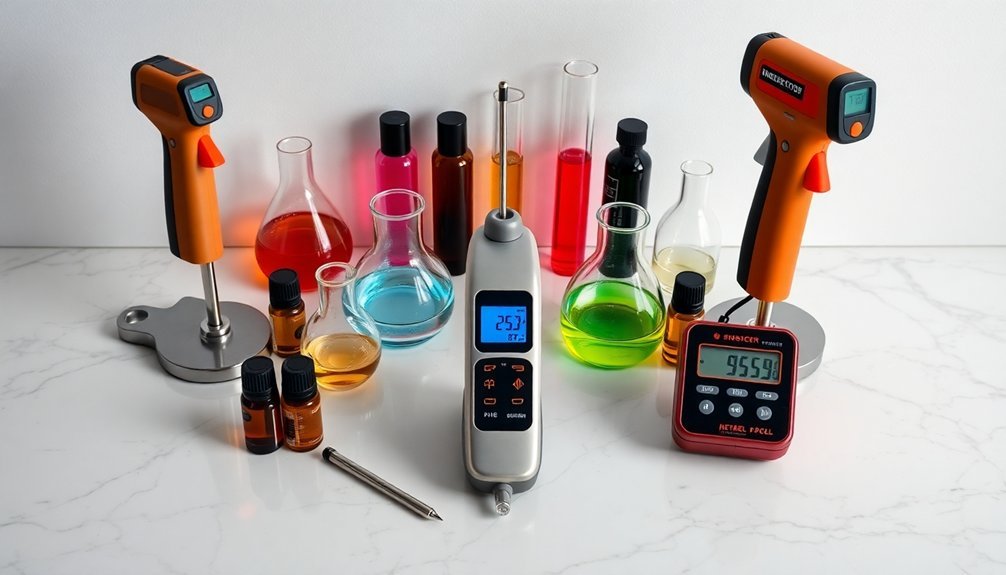
Your choice between digital and infrared thermometers can make a significant difference in your soap-making success, with infrared options offering the fastest readings at around 100°F (38°C) for ideal results.
While digital kitchen thermometers provide reliable measurements that help prevent soap cracking and essential oil degradation, infrared models give you contactless convenience and instant feedback during the temperature-sensitive process.
You'll want to check temperatures frequently during mixing and blending, especially when using a stick blender, to maintain consistent heat levels that protect your aromatic ingredients and guarantee proper saponification.
Digital vs. Infrared Thermometers
Temperature monitoring stands as one of the most critical aspects of soap making, and choosing between digital and infrared thermometers can greatly impact your process.
You'll find that digital thermometers offer precise readings through direct contact, while infrared thermometers provide quick, non-contact measurements of your lye solution and oils.
Consider these key differences when selecting your temperature control tool:
- Digital thermometers require insertion but deliver highly accurate internal readings
- Infrared thermometers offer safer, contact-free measurement of surface temperatures
- Digital models work best for ensuring thorough temperature consistency
- Infrared options help prevent cross-contamination between batches
- Both types should measure beyond 200°F for complete process monitoring
Remember to calibrate your thermometer regularly, regardless of which type you choose, to maintain the accuracy needed for successful soap making.
Temperature Tracking Guidelines
While crafting handmade soap requires attention to many details, proper temperature tracking stands out as a cornerstone of success. You'll need to maintain both your oils and lye solution at around 100°F (38°C) to achieve consistent results and prevent common issues like cracking.
A digital kitchen thermometer offers quick, accurate readings during the entire process, especially when monitoring temperatures during emulsification and the critical gel phase.
You'll want to keep a close eye on your soap's temperature as it can climb between 160°F and 200°F during this phase, which directly impacts your scent retention and final product quality.
While glass thermometers can work, they're slower and more fragile than their digital counterparts. For the best results, invest in either a digital or infrared thermometer to guarantee precise measurements throughout your soap-making journey.
Essential Oil Storage and Handling Solutions
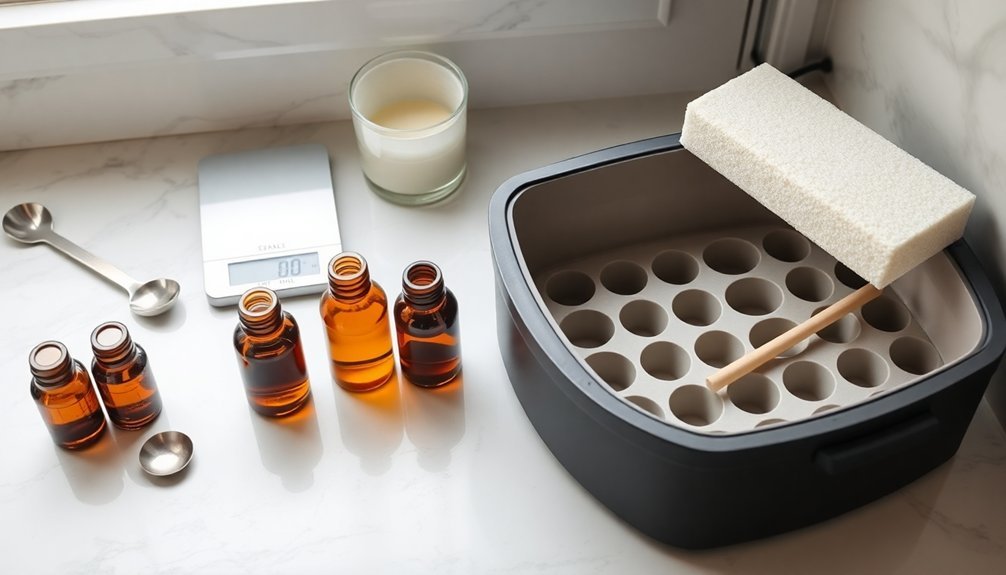
Proper storage and handling of essential oils is crucial for maintaining their therapeutic properties and extending their usefulness in soap making.
Taking proper care to store and handle essential oils protects their potency and helps ensure successful soap-making results.
You'll need to store your oils in dark glass bottles and keep them in a cool, dry space away from direct sunlight to preserve their potency. Create a dedicated storage area where temperatures stay below 70°F (21°C).
To prevent contamination and track freshness, follow these essential practices:
- Use droppers or pipettes when dispensing oils
- Store bottles in dark amber or cobalt glass containers
- Label each bottle with oil name and purchase date
- Monitor storage temperature consistently
- Check regularly for changes in color, scent, or consistency
Remember to rotate your stock based on purchase dates and always handle oils with clean tools to maintain their quality for your soap-making projects.
Mold Selection and Preparation Materials
Now that you've organized your essential oils, selecting the right molds and preparing them correctly will shape your soap-making success. Your mold selection will greatly impact the final product's appearance and ease of removal.
Silicone molds offer the most versatility, allowing you to easily pop out your finished soaps thanks to their flexible nature. If you're working with wooden box molds, don't forget to line them with wax paper for hassle-free removal.
Cavity molds are perfect when you want to create intricate designs, though they'll require extra care during the unmolding process. For beginners or small batches, cleaned milk cartons provide an economical alternative.
Proper preparation is essential regardless of your choice. Always verify your molds are clean, completely dry, and free from residue before pouring your soap mixture.
Cutting and Shaping Equipment
Your soap-making toolkit should include a steel wire cutter to achieve professional-looking bars with clean, uniform cuts.
You'll find that multi-bar cutters speed up production while maintaining consistency across batches, especially when working with large soap blocks.
For detailed designs or specialty shapes, keep both a non-serrated kitchen knife and soap shaver on hand to perfect your final product's appearance.
Professional Bar Cutting Tools
Professional bar cutting tools serve as essential equipment for creating uniform, marketable soap bars.
You'll find that steel wire soap cutters deliver precise cuts while maintaining a professional appearance. When you're scaling up production, multi-bar cutters become invaluable, letting you slice several bars simultaneously to save precious time.
To achieve flawless results, consider these essential cutting tools:
- Steel wire soap cutters for consistent, clean cuts
- Multi-bar cutters to boost production efficiency
- Soap shavers to remove surface imperfections
- Custom-built cutters for unique bar shapes
- Non-serrated kitchen knives as basic alternatives
A soap shaver is particularly vital for removing soda ash and knife marks, ensuring your bars maintain their polished finish.
Whether you choose specialized equipment or basic alternatives, the right cutting tools will help you achieve uniform bar sizes and professional results.
Mold Release Solutions
While crafting handmade soaps requires artistic skill, successful unmolding demands practical solutions to prevent sticking and damage.
You'll find that silicone molds are your best option for consistently smooth results. These flexible containers used in soap making release your bars effortlessly, maintaining their pristine appearance.
If you're working with wooden box molds, don't skip the essential step of lining them with wax paper. This simple mold release solution will save you frustration and protect your soap's finish.
When selecting cavity molds, make sure they're both sturdy and flexible enough to withstand the unmolding process.
Whichever type of soap molds you choose, proper preparation is key. Remember that a Silicone Loaf Mold offers the most reliable results for beginners and experienced crafters alike.
Natural Colorant Processing Tools
Creating vibrant, naturally-colored soaps requires specific tools to properly process and incorporate organic colorants into your soap formulations.
You'll need a variety of grinders and sieves to break down herbs, spices, and clays into usable pigments. An immersion blender guarantees thorough mixing, while silicone molds showcase your colorful creations perfectly.
Essential tools for processing natural colorants include:
- Electric grinder or mortar and pestle for breaking down dried botanicals
- Fine mesh sieve for removing larger particles
- Mini mixer for initial color dispersion
- Silicone molds for easy removal and color display
- Mixing bowls dedicated to colorant preparation
When you're working with natural colorants, proper processing tools make the difference between streaky, uneven soap and professional-looking bars with uniform color distribution throughout.
Curing and Storage Solutions
Once you've poured your aromatherapy soap, proper curing and storage become crucial for preserving its therapeutic properties and extending its shelf life.
You'll need a dedicated cool, dry area where your soap can cure undisturbed for 4-6 weeks during saponification.
For storage solutions, invest in breathable containers or cardboard boxes rather than plastic ones, which can trap moisture and compromise your soap's quality.
Wrap your cured bars in wax paper or place them in muslin bags to protect their essential oils while maintaining proper air circulation.
Create a simple labeling system that includes the production date and essential oils used, making it easier to track each batch's shelf life.
This organized approach guarantees your handcrafted soaps maintain their therapeutic benefits and aromatic properties over time.
Essential Oil Testing and Quality Assessment Tools
A well-cured soap deserves high-quality essential oils to reach its full therapeutic potential. To guarantee you're using the best ingredients, you'll need reliable essential oil testing and quality assessment tools. Gas chromatography and mass spectrometry provide detailed analysis of oil purity, while a refractometer helps you verify specific gravity for consistent results.
Don't forget these critical testing components:
- Use a pH meter to monitor your soap's acidity levels
- Perform sensory evaluation through smell tests and skin patches
- Document flashpoints for safety and scent retention
- Track evaporation rates to predict fragrance longevity
- Record specific gravity measurements for batch consistency
These tools help you create safe, effective aromatherapy soaps while maintaining quality standards.
Remember to keep detailed records of your test results for future reference and recipe refinement.
Documentation and Recipe Management Systems
Effective documentation serves as the backbone of successful aromatherapy soap making. You'll need a thorough system to track your essential oil blends, usage rates, and recipe modifications.
Thorough documentation and tracking systems form the foundation of mastering aromatherapy soap making and creating consistent, successful blends.
Start by implementing recipe management software that lets you organize and scale your formulations with ease.
Create a detailed log to monitor how different essential oils perform and document any fragrance fading over time.
Keep your safety guidelines readily accessible in a digital or physical binder, including maximum usage rates for essential oils (5-30%).
Include photographs of your finished soaps alongside scent descriptions to build a visual reference library.
Frequently Asked Questions
What Tools Are Needed for Soap Making?
You'll need a digital kitchen scale, immersion blender, thermometer, stainless steel containers, safety goggles, and protective gloves. These tools guarantee accurate measurements, proper mixing, temperature control, and safe handling during soap making.
What Is the Most Popular Scent for Homemade Soap?
Lavender is your best bet for homemade soap, as it's consistently the most popular scent choice. You'll love its calming properties, and it's easy to work with in your soap-making projects.
What Essential Oils Go Well Together in Soap?
You'll find lavender pairs beautifully with cedarwood or patchouli, while citrus oils blend well with litsea cubeba. For warm scents, try vanilla oleoresin with Peru Balsam or dark patchouli with coffee absolute.
Which Essential Oils Last Longest in Soap?
You'll get the longest-lasting scents from patchouli, cedarwood, and litsea cubeba in your soaps. These base and middle notes stick around better than lighter oils, especially when you blend them together.
In Summary
You'll set yourself up for DIY aromatherapy soap success by investing in these essential tools and systems. From precise measuring equipment to safety gear and specialized mixing tools, you're now equipped to create professional-quality soaps. Don't forget to maintain your documentation system and quality testing tools. With proper storage solutions and temperature monitoring devices, you're ready to start your aromatherapy soap-making journey.

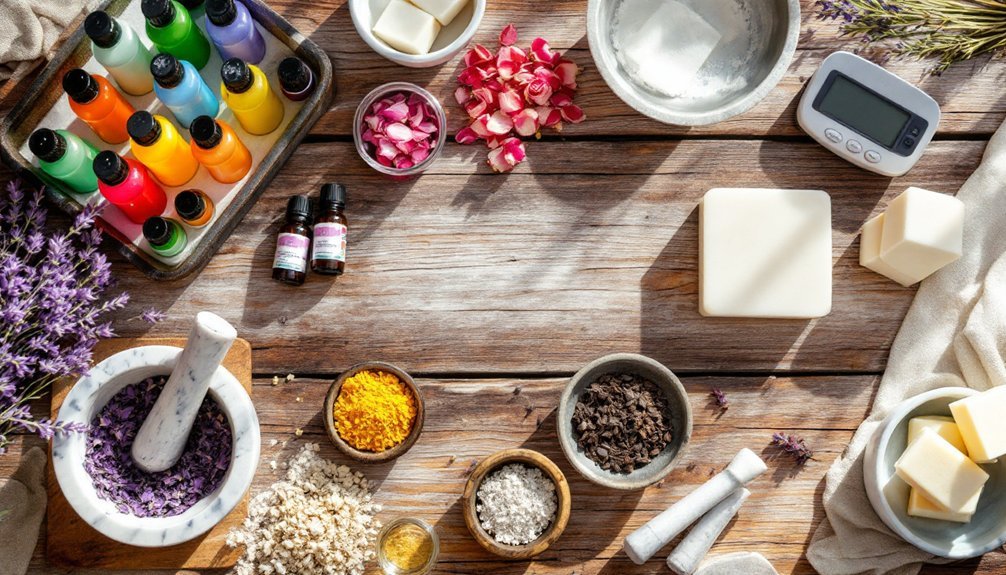



Leave a Reply